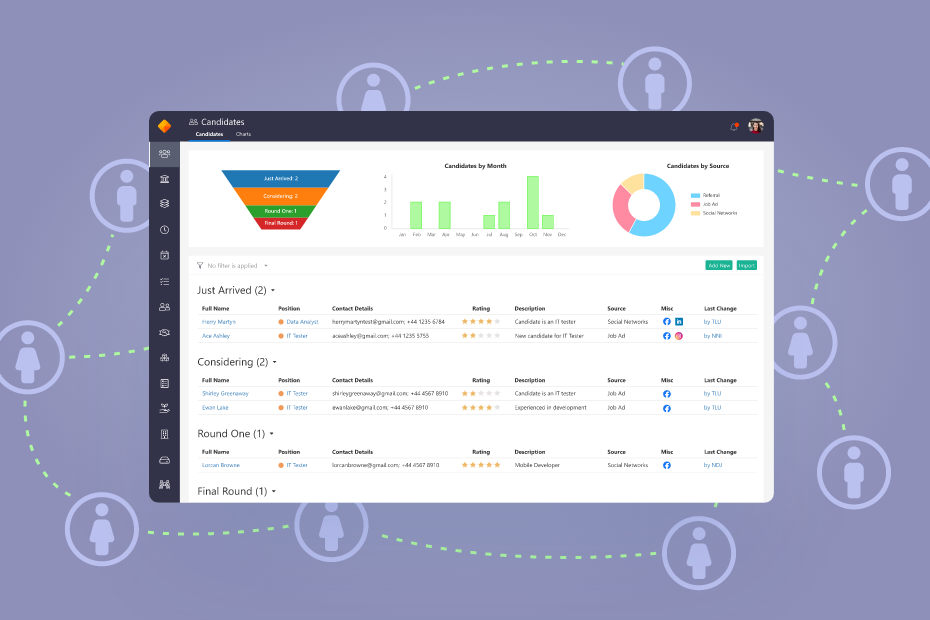
One of the major tasks that can quickly overwhelm a growing company is its talent management activities. From creating job posts and screening applications to finalizing recruitment and training, it takes a lot of effort and attention to detail to get the right candidate. And when such a heavy process is done manually, it could lead to multiple issues like manual errors, lag in productivity, and overall inefficiency in talent management. With the help of applicant tracking systems, you can automate some of the bulky document tasks, such as application tracking, which is a good way to optimize the overall recruitment process.
What is an applicant tracking system?
An applicant tracking system is a software application that helps companies track the applications sent regarding their job posts. It is often bundled together with larger recruitment management systems that are used to manage the overall recruitment process. Application tracking systems carry out many routine tasks involved in the recruitment process such as scheduling phone calls, arranging times for an interview, application screening, and more.
Is there a difference between an applicant tracking system and a candidate management system?
In essence, applicant tracking systems work quite similar to candidate management systems. However, their workflows are designed differently. While candidate management systems are used for year-round candidate management tasks, application tracking systems are focused on streamlining the recruitment process and acting as a compliance tool.
Candidate management systems perform repetitive tasks that are carried out both actively and passively behind the scenes to keep track of all possible candidates. But application tracking systems can go beyond doing repetitive tasks and can help you optimize your recruitment process. Some common features of applicant tracking systems include:
- Career page management
- Job distribution
- Managing stored applications
- Team collaboration
- Onboarding
- Interview scheduling
- Social sharing
How do applicant tracking systems work?
The tasks that are automated by applicant tracking systems are centered around the job applications in a recruitment process. It is used to optimize applicant management by providing recruiters with tools that can be used across various stages of the recruitment process. By streamlining the data through the recruitment workflows, it ensures no errors are made and no data is lost. The applicant tracking system generally tracks down a job applicant from the job posting stage to the final resume processing stage.
Every resume that forms part of a job application is efficiently handled across the various stages and stored in the candidate archival to be used as and when necessary.
All interactions with the applicant are duly recorded. Resumes that are received through multiple channels, whether that’s an old-school postal mail or email inquiries, are all properly digitized and stored in an optimized manner.
Applicant tracking systems also help you analyze the resumes for the desired information and thus help with quick and effective resume screening.
Throughout the recruitment process, the candidate's journey is recorded for future use, such as understanding what attracts skilled applicants.
A step to automating the hiring process
Applicant tracking systems offer an easy way to automate and optimize data-intensive operations that form part of the recruitment process.
Not only does it help speed up the recruitment process, but it also helps you find ways to improve it. Around 40% of companies prefer to use an applicant tracking system to keep up with the need for skilled resources. If small companies are to compete with larger players in the market, they need to be able to take advantage of automation tools such as applicant tracking systems.
Benefits of an applicant tracking system
Easy evaluation of candidates
By automating resume screening, you can reduce the time it takes to select suitable candidates for a job. The same tasks, when done manually, can be time-consuming and prone to errors.
Read on: How to boost your employees’ performance with feedback
Sourcing and managing applicants
The competition is quite fierce when recruiting talented people for a job. You don't want to lose prospective candidates over a lengthy recruitment process or through miscommunication.
Coordinated and seamless hiring
Applicant tracking systems can integrate with your existing ERP systems and allow for uniform and consistent data to be shared across your various teams and departments. This helps you improve team collaboration and streamline the hiring process.
Reduced time to hire
According to a 2020 stat, on average, it takes about 27 days to replace a candidate. This is quite a long time considering the shortage of talent in the market. Applicant tracking systems allow you to speed up the recruitment process by helping you contact the applicants quicker and reach out to them through multiple channels like email, phone calls, etc. Rescheduling interviews and phone calls can all be fastened with the help of applicant tracking systems.
Read on: How to streamline your recruitment process
A modular ERP with applicant tracking
Applicant tracking works best when you can integrate it with your ERP system. While most ERP applications provide a comprehensive set of features, you may not require every feature they offer. Having the choice to pick and choose the modules you need and only pay for those is the right way for any growing company. As you scale up, you need to be wary of your expenses, and a modular ERP helps you save money and achieve optimized workflows.
Vault is a highly rated modular ERP tool that can function as your all-in-one business tool. It also offers an applicant tracking feature that will help you manage all your applicant management requirements.
Read on: 8 ways Vault can help your HR department
